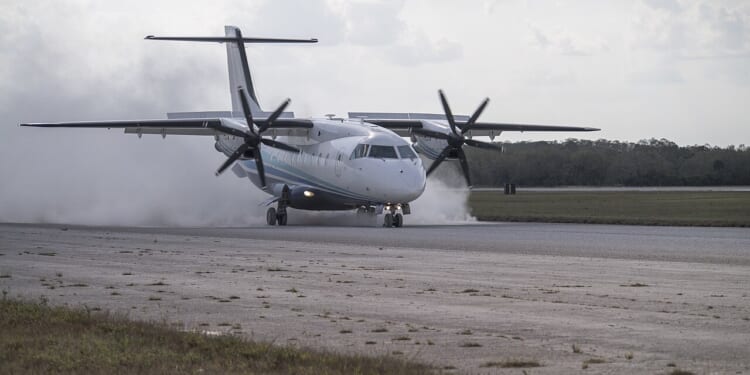A recent C-146A Wolfhound flight near the Venezuelan coastline has raised suspicions of covert activity, even though the Wolfhound had its transponder on.
The Trump administration continues its buildup along the coastline of Venezuela, despite rumors abounding that the 47th president is backing away from his original decision to escalate his administration’s attacks against the regime of Nicolas Maduro in Venezuela.
Reports have been coming in over the last week that American special forces units were spotted in the areas near Venezuela. This comes on the heels of the Trump administration authorizing the CIA to conduct covert operations in the country.
What’s Going on in the Skies Near Venezuela?
A C-146A Wolfhound, which is a specialized transport plane used by the United States Air Force Special Operations Command (AFSOC), was tracked on a route near Venezuelan airspace while en route to Colombia. This comes after several American bombers, such as the B-1B Lancer and B-52H Stratofortress, also flew missions in the Caribbean Sea close to the Venezuelan coast.
What’s more, helicopters associated with US Special Operations aviation (such as MH-6 Little Birds and MH-60 Black Hawks) were spotted operating in Caribbean waters less than 90 miles away from Venezuela. It is assumed that these elements were conducting training or mission-preparation flights (or both).
Defence Blog, which was among the first to report the aforementioned C-146A Wolfhound flight, described that flight as being “low-profile” and on a route that brought it along the northern coastline of South America, passing very near to Venezuelan territory (while still maintaining its flight over international waters). The C-146A is the perfect vehicle for the kind of stealthy missions that American special forces operators routinely engage in, especially when the country is on the brink of a potential war—such as we appear to be as of this moment.
What Does the Army Use the C-146A For, Exactly?
The C-146A is used for discreet mobility, infiltration and exfiltration of special operations forces, and supporting missions in austere conditions. The proximity of these flights to Venezuelan airspace (which can come as close as tens of miles) raises questions about the Pentagon’s strategic signaling, readiness for operations, or deterrence posture toward the Maduro regime of Venezuela.
These were obviously not clandestine operations, though. The transponders on these planes and helicopters were all active, and were using callsigns that would have been immediately recognizable as belonging to Special Forces units. It was clear that these movements were instead part of a broader signaling campaign undertaken by the Trump administration to compel cooperation from Maduro’s regime.
So, while these flights have basically been blatant, there are no indications that any incursions into Venezuela have occurred. Thus far, it appears to be basically smoke and mirrors. The precise mission of the C-146A flight and the other sorties remains unknown.
What Game Is Trump Playing in Venezuela?
So, yes, Special Forces-linked aircraft have been observed flying in the Caribbean Sea near Venezuela. These flights appear to form part of a broader American posture of increasing aerial and maritime presence in the region—ostensibly for counternarcotics, but interpreted by observers as strategic warning or deterrence to the Venezuelan government.
It remains to be seen if any of these flights amount to anything substantive, or if they are just more posturing from the Trump administration.
Right now, the United States looks weak. While the United States should avoid a war, the fact that the Trump administration has been beating its chest and baring its teeth at Maduro’s regime, with no real interest in following through on those threats, means that it comes off as indecisive and weak.
About the Author: Brandon J. Weichert
Brandon J. Weichert is a senior national security editor at The National Interest. Recently, Weichert became the host of The National Security Hour on America Outloud News and iHeartRadio, where he discusses national security policy every Wednesday at 8pm Eastern. He is also a contributor at Popular Mechanics and has consulted regularly with various government institutions and private organizations on geopolitical issues. Weichert’s writings have appeared in multiple publications, including The Washington Times, National Review, The American Spectator, MSN, and the Asia Times. His books include Winning Space: How America Remains a Superpower, Biohacked: China’s Race to Control Life, and The Shadow War: Iran’s Quest for Supremacy. His newest book, A Disaster of Our Own Making: How the West Lost Ukraine is available for purchase wherever books are sold. He can be followed via Twitter @WeTheBrandon.
Image: Wikimedia Commons.

















